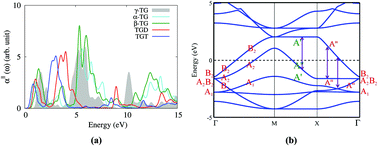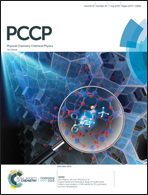Acetylenic linkage dependent electronic and optical behaviour of morphologically distinct ‘-ynes’†
Abstract
We have critically examined the key role of acetylenic linkages (–C![[triple bond, length as m-dash]](https://www.rsc.org/images/entities/char_e002.gif) C–) in determining the opto-electronic responses of dynamically stable tetragonal (T) ‘-ynes’ with the help of a density functional theory method. The presence of –C
C–) in determining the opto-electronic responses of dynamically stable tetragonal (T) ‘-ynes’ with the help of a density functional theory method. The presence of –C![[triple bond, length as m-dash]](https://www.rsc.org/images/entities/char_e002.gif) C– between two tetra-rings invariably flips the electronic bands about the Fermi level. The underlying physics has been critically addressed with the help of a real space renormalization group (RSRG) scheme under a tight binding (TB) approximation. Besides, we have proposed an elegant approach to introduce and tune a band gap in the customarily metallic T graphene allotrope. The quantum dots of these systems exhibit diode like current–voltage (I–V) characteristics and can be used in negative differential resistance devices. In addition, the anisotropic optical properties evidently support the electronic states of the systems. In particular, the static dielectric constants for some of these ‘-ynes’ are enhanced compared to graphene and T graphene. The effective number of electrons participating in an interband transition shows saturation over 30 eV. Furthermore, electron energy loss spectra (EELS) peaks are consistent with the plasma frequencies of the corresponding systems. The intrinsic responses of the –C
C– between two tetra-rings invariably flips the electronic bands about the Fermi level. The underlying physics has been critically addressed with the help of a real space renormalization group (RSRG) scheme under a tight binding (TB) approximation. Besides, we have proposed an elegant approach to introduce and tune a band gap in the customarily metallic T graphene allotrope. The quantum dots of these systems exhibit diode like current–voltage (I–V) characteristics and can be used in negative differential resistance devices. In addition, the anisotropic optical properties evidently support the electronic states of the systems. In particular, the static dielectric constants for some of these ‘-ynes’ are enhanced compared to graphene and T graphene. The effective number of electrons participating in an interband transition shows saturation over 30 eV. Furthermore, electron energy loss spectra (EELS) peaks are consistent with the plasma frequencies of the corresponding systems. The intrinsic responses of the –C![[triple bond, length as m-dash]](https://www.rsc.org/images/entities/char_e002.gif) C– in these systems are extremely important for basic science and nanodevice research.
C– in these systems are extremely important for basic science and nanodevice research.



 Please wait while we load your content...
Please wait while we load your content...